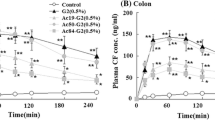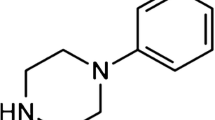Abstract
Purpose
To investigate the transport of poly(amidoamine) (PAMAM) dendrimers with positive, neutral and negatively charged surface groups across Caco-2 cell monolayers.
Methods
Cationic PAMAM-NH2 (G2 and G4), neutral PAMAM-OH (G2), and anionic PAMAM-COOH (G1.5–G3.5) dendrimers were conjugated to fluorescein isothiocyanate (FITC). The permeability of fluorescently labeled PAMAM dendrimers was measured in the apical-to-basolateral direction. 14C-Mannitol permeability was measured in the presence of unlabeled and FITC labeled PAMAM dendrimers. Caco-2 cells were incubated with the dendrimers followed by mouse anti-occludin or rhodamine phalloidin, and visualized using confocal laser scanning microscopy to examine tight junction integrity.
Results
The overall rank order of PAMAM permeability was G3.5COOH > G2NH2 > G2.5COOH > G1.5COOH > G2OH. 14C-Mannitol permeability significantly increased in the presence of cationic and anionic PAMAM dendrimers with significantly greater permeability in the presence of labeled dendrimers compared to unlabeled. PAMAM dendrimers had a significant influence on tight junction proteins occludin and actin, which was microscopically evidenced by disruption in the occludin and rhodamine phalloidin staining patterns.
Conclusions
These studies demonstrate that enhanced PAMAM permeability is in part due to opening of tight junctions, and that by appropriate engineering of PAMAM surface chemistry it is possible to increase polymer transepithelial transport for oral drug delivery applications.





Similar content being viewed by others
Abbreviations
- FITC:
-
Fluorescein isothiocyanate
- G:
-
Generation
- HBSS:
-
Hank’s balanced salt solution
- PAMAM:
-
Poly(amidoamine)
- TEER:
-
Transepithelial electrical resistance
References
N. Pantzar, L. Lundin, L. Wester, and B. R. Westrom. Bidirectional small-intestinal permeability in the rat to some common marker molecules. Scand. J. Gastroenterol. 29:703–709 (1991).
D. A. Tomalia, A. M. Naylor, and W. A. Goddard III. Starburst dendrimers. Molecular-level control of size, shape, surface chemistry, topology, and flexibility from atoms to macroscopic matter. Angew. Chem. Int. Ed. Engl. 29:138–175 (1990).
T. Kuhl, Y. Guo, J. L. Alderfer, A. D. Berman, D. Leckband, J. Israelachvili, and S. W. Hui. Direct measurement of polyethlyene glycol induced depletion attraction between lipid bilayers. Langmuir 12:3003–3014 (1996).
R. Jevprasesphant, J. Penny, D. Attwood, and A. D’Emanuele. Transport of dendrimer nanocarriers through epithelial cells via the transcellular route. J. Control Release 97:259–267 (2004).
R. Wiwattanapatapee, B. Carreno-Gomez, N. Malik, and R. Duncan. Anionic PAMAM dendrimers rapidly cross adult rat intestine in vitro: a potential oral delivery system? Pharm. Res. 17:991–998 (2000).
F. Tajarobi, M. El-Sayed, B. D. Rege, J. E. Polli, and H. Ghandehari. Transport of poly amidoamine dendrimers across Madin–Darby Canine Kidney cells. Int. J. Pharm. 215:263–267 (2001).
M. El-Sayed, M. Ginski, C. Rhodes, and H. Ghandehari. Transepithelial transport of poly(amidoamine) dendrimers across Caco-2 cell monolayers. J. Control Release 81:355–365 (2002).
M. El-Sayed, M. Ginski, C. Rhodes, and H. Ghandehari. Influence of surface chemistry of poly(amidoamine) dendrimers on Caco-2 cell monolayers. J. Bioact. Compat. Polym. 18:7–22 (2003).
A. D’Emanuele, R. Jevprasesphant, J. Penny, and D. Attwood. The use of a dendrimer-propranolol prodrug to bypass efflux transporters and enhance oral bioavailability. J. Control. Release 95:447–453 (2004).
R. Jevprasesphant, J. Penny, D. Attwood, N. B. McKeown, and A. D’Emanuele. Engineering of dendrimer surfaces to enhance transepithelial transport and reduce cytotoxicity. Pharm. Res. 20:1543–1550 (2003).
R. Jevprasesphant, J. Penny, R. Jalal, D. Attwood, N. B. McKeown, and A. D’Emanuele. The influence of surface modification on the cytotoxicity of PAMAM dendrimers. Int. J. Pharm. 252:263–266 (2003).
D. A. Tomalia. Birth of a new macromolecular architecture: dendrimers as quantized building blocks for nanoscale synthetic organic chemistry. Aldrichimica Acta 37:39–57 (2004).
R. Esfand, and D. A. Tomalia. Poly(amidoamine) (PAMAM) dendrimers: from biomimicry to drug delivery and biomedical applications. Drug Discov. Today 6:427–436 (2001).
M. El-Sayed, M. F. Kiani, M. D. Naimark, A. H. Hikal, and H. Ghandehari. Extravasation of poly(amidoamine) (PAMAM) dendrimers across microvascular network endothelium. Pharm. Res. 18:23–28 (2001).
J. D. Irvine, L. Takahashi, K. Lockhart, J. Cheong, J. W. Tolan, H. E. Selick, and J. R. Grove. MDCK (Madin–Darby Canine Kidney) cells: a tool for membrane permeability screening. J. Pharm. Sci. 88:28–33 (1998).
F. A. Dorkoosh, C. A. Broekhuizen, G. Borchard, M. Rafiee-Tehrani, J. C. Verhoef, and H. E. Junginger. Transport of octreotide and evaluation of mechanism of opening the paracellular tight junctions using superporous hydrogel polymers in Caco-2 cell monolayers. J. Pharm. Sci. 93:743–752 (2004).
A. B. J. Noach, Y. Kurosaki, M. C. M. Blom-Roosemalen, A. G. D. Boer, and D. D. Breimer. Cell-polarity dependant effect of chelation on the paracellular permeability of confluent Caco-2 cell monolayers. Int. J. Pharm. 90:229–237 (1993).
M. El-Sayed, C. A. Rhodes, M. Ginski, and H. Ghandehari. Transport mechanism(s) of poly(amidoamine) dendrimers across Caco-2 cell monolayers. Int. J. Pharm. 265:151–157 (2003).
Y. Chen, C. Merzdorf, D. L. Paul, and D. A. Goodenough. COOH terminus of occludin is required for tight junction barrier function in early Xenopus embryos. J. Cell Biol. 138:891–899 (1997).
J. M. Anderson and C. M. van Itallie. Tight junctions and the molecular basis for regulation of paracellular permeability. Am. J. Physiol. 269:G467–G475 (1995).
J. M. Anderson, C. M. Van Itallie, M. D. Peterson, B. R. Stevenson, E. A. Carew, and M. S. Mooseker. ZO-1 mRNA and protein expression during tight junction assembly in Caco-2 cells. J. Cell Biol. 109:1047–1056 (1989).
L. Knutson, F. Knutson, and T. Knutson. Permeability in the gastrointestinal tract. In J. B. D. H. Lennernäs (ed.), Oral Drug Absorption: Prediction and Assessment, Marcel Dekker, New York, 2000, pp. 11–16.
Acknowledgments
The authors would like to acknowledge Amy Foraker for her assistance with the confocal microscopy studies. Kelly Kitchens received financial support for this research by a pre-doctoral National Research Service Award from the National Institute of General Medical Sciences (F31-GM67278).
Author information
Authors and Affiliations
Corresponding author
Rights and permissions
About this article
Cite this article
Kitchens, K.M., Kolhatkar, R.B., Swaan, P.W. et al. Transport of Poly(Amidoamine) Dendrimers across Caco-2 Cell Monolayers: Influence of Size, Charge and Fluorescent Labeling. Pharm Res 23, 2818–2826 (2006). https://doi.org/10.1007/s11095-006-9122-2
Received:
Accepted:
Published:
Issue Date:
DOI: https://doi.org/10.1007/s11095-006-9122-2




